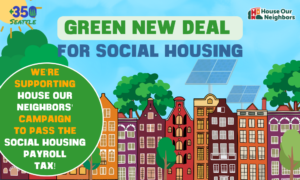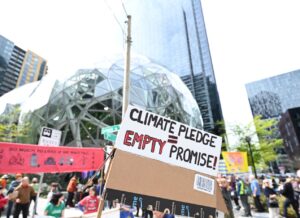Mayor Durkan announced a study of congestion pricing on Wednesday. We support this study, and strongly urge a bottom-line focus on equity, including consultation with low-income communities.
Done right, congestion pricing puts the burden of cost on higher-income single-occupancy-vehicle (SOV) drivers, and devotes that revenue to improved transit for all; this means that we get a fairer city, a less polluted city, and a city with more room for rapid transit, pedestrians, and bicyclists.
Seattleites who spend an average of 55 hours each year stuck in traffic jams will not be surprised to learn Seattle is the 20th most congested city in the world, and ninth in the US. This is socially and environmentally costly from a number of standpoints – wasted time, traffic deaths and injuries, local air and water pollution, and, most devastatingly, carbon emissions that cause global climate disruption.
Congestion pricing, by more accurately reflecting the real costs of driving, can deeply reduce those impacts, and provide much-needed resources for alternatives to driving. That is why 350 Seattle supports equitably designed congestion pricing in Seattle, and will be pushing on the Mayor and the City to implement it as fairly as possible, and as soon as possible, with all revenues going to transit and to other methods of minimizing the impact to lower-income people who currently have no choice but to drive to work in the city.
Congestion pricing is a tolling system that sets varying charges for road use—generally dependent on time of day. It can include tolling on stretches of highway or for entry to districts, typically downtowns. Five large cities around the world have implemented downtown congestion pricing, including London, Milan, Singapore, and in Sweden, Stockholm and Gothenburg. No North American city has downtown congestion pricing yet; New York City had a proposal that has recently been watered down and made much less equitable. By designing a genuinely progressive and effective system, Seattle could lead the nation on this, and provide a model for other cities.
London’s is the best-known example of downtown congestion pricing. Since 2003, from 7am to 6pm Monday through Friday, entry costs £11.50 (~$16 as of April 2018). As of October 2017, an additional £10 is levied on high-polluting vehicles (~$14 as of April 2018). Low-polluting vehicles including electric and some plug-in hybrid cars are exempt. Control gantries read license plates. Payment can be made by web, phone or at local kiosks, with substantial penalties for failure to pay. The program provides around $300 million annually to support transit.
Singapore in 1975 was the first successful introduction of a congestion pricing system. It covers 7.25 square kilometers as well as three expressways, and in 1998 became the world’s first fully electronically tolled congestion scheme. License plates are read at control gantries and owners are automatically charged.
Milan implemented its downtown congestion pricing system for most vehicles in January 2012, based on an earlier system that exempted a large number of lesser polluting vehicles. Entry into the cordoned area during weekday hours costs €5 ($61.5 as of April 2108). An eight-week suspension of the system due to a court ruling provided an immediate indication of how effective it was. Traffic and pollution immediately spiked. Even with that gap, benefits were still tremendous. From 2011 to 2012, traffic dropped 31% percent, particulates 18% and carbon pollution 35%. The $21 million raised by the program that year went to transit and bicycle access.
Studies indicate substantial social and environmental benefits from congestion pricing. A 2011 study by C40 Cities found that the London system:
- Cut traffic levels in the priced area by 20%, or 75,000 vehicles per day, and around the area by 30%, during charged hours
- Reduced carbon dioxide emissions within the area by 15%, or 30,000 metric tons per year, and around 100,000 metric tons across the London metro, much from lowering the amount of fuel burned in traffic jams
- Reduced NOx emissions 13% and PM10 emissions 15%
- Increased transit trips by around 40,000 per day, and bicycle trips by 83%.
- Decreased traffic deaths and injuries by 40-70 annually in the charged area –A University of Lancaster study found 40% fewer traffic collisions per mile driven in the area.
The study found that the retail sector in the area was outperforming the national average, while no impact of congestion pricing could be detected on commercial property values.
A University of Washington Evans School study found that a weekday charge of $2.15 – Stockholm’s original charge – to enter an area bounded by I-5, Puget Sound, Denny Avenue and S. King Street would:
- Provide $585 million in benefits to the region over a 30-year period on a net present value basis.
- Generate $109 million/year in revenues
- Reduce carbon emissions 12%, carbon monoxide 14%, NOx by 8.5%, and particulates by 14%
- Cut traffic accidents by 3.6%
- Reduce overall travel time inside and outside the cordon by 3.5%
- Increase transit usage by 9.2%.
While the benefits are indisputable, congestion pricing raises equity questions, since it can add a cost burden for lower-income people. A number of studies have been done on this issue. In general, they conclude that properly structured congestion pricing systems will tend to be progressive rather than regressive for lower-income communities. Most important is that revenues be invested in transit and other transport options, which are more likely to be used by lower-to-moderate income people. 350 Seattle supports dedicating these revenues to transit.
Notes Todd Littman of Victoria Transport Policy Institute, “. . . road tolls are generally less regressive than financing urban highway expansion by increasing fuel taxes (which all motorists pay, not just urban commuters) or general taxes (which everybody pays regardless of how much they drive), and can be progressive overall if a portion of revenues are used to improve alternative modes, such as public transit, so lower-income travellers have better alternatives to driving.”
A study done in advance of Stockholm’s congestion pricing implementation found, “If revenues are used for improving public transport, this will benefit women and low-income groups the most. Given that it is likely that the revenues will be used to some extent to improve the public transport system, we conclude that the proposed congestion-charging scheme for Stockholm is progressive rather than regressive.”
Incomes of people who commute by car, and at peak hours, are much greater on average than people who commute by transit, biking and walking. A Portland study shows the average family income of people who drive to work is $73,600, versus $44,700 for people who use transit. Congestion pricing will reduce transit times and travel times in general.
Congestion pricing’s reduced pollution, noise and traffic deaths can disproportionately benefit disadvantaged communities. Studies of congestion pricing in eight United Kingdom communities have found “that the reduction of emissions from motor vehicles after the cordon charge have been both sizable and steeply progressive in their distribution of air quality benefits.”
If Stockholm had not instituted congestion pricing in 2006, over the next four years air would have been 5-10% more polluted, and young children would would have experienced 45% more asthma attacks from 2006-10, a Johns Hopkins University study concludes.
Congestion pricing can bring similar gains to Seattle, substantially reducing congestion, pollution and road injuries, while supporting transportation options that benefit everyone, and lower-income communities most of all. It all depends on how the system is structured, and the revenues are spent. 350 Seattle supports an equitable congestion pricing system for Seattle to move us beyond car dependence to a 21st century transportation system that reduces carbon pollution and global warming. Free street space is anything but free in terms of local and global impacts. We need to quickly make driving reflect its true costs, and congestion pricing is a step in that direction.
We urge the City to perform a careful study and to engage in meaningful consultation that leads to rapid implementation of a truly equitable congestion pricing policy. We can’t afford to wait.








